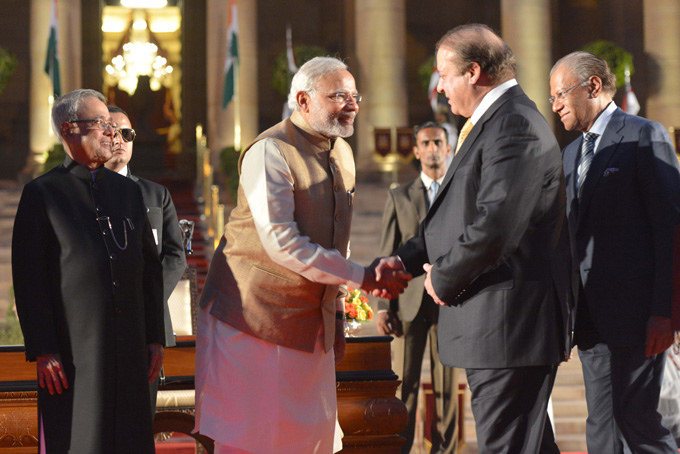 The growing India-chatter within foreign policy circles has recently intensified after the election of the most ‘Indian’ of Indian Prime Ministers in decades. Many have speculated whether Modi’s cultural-nationalist past will define his foreign policy. The new PM had previously criticised Congress’ approach as ‘weak’. And his new External Affairs Minister, Sushma Swaraj, had made hawkish comments on Pakistan. But, in terms of actual policy, Modi is likely to continue the centrist drift we saw during the election.
The growing India-chatter within foreign policy circles has recently intensified after the election of the most ‘Indian’ of Indian Prime Ministers in decades. Many have speculated whether Modi’s cultural-nationalist past will define his foreign policy. The new PM had previously criticised Congress’ approach as ‘weak’. And his new External Affairs Minister, Sushma Swaraj, had made hawkish comments on Pakistan. But, in terms of actual policy, Modi is likely to continue the centrist drift we saw during the election.
India’s foreign policy has long been determined by a triple bottom line—interests, values and public opinion. All three are relatively impervious to changes of government. Each BJP policy will adhere to at least one of those drivers, and the degree of change from previous policy will be determined by how the government interprets each driver and how readily changes can be pushed through a strong-willed foreign service.
When it comes to China, Modi will put interests first. In recent years, the growing economic relationship has acted as an anchor to more erratic strategic relations. As Gujarat Chief Minister, Modi himself visited China several times to build trade ties.
But long-simmering tensions—based on border disputes and Chinese support for Pakistan—hold back positive relations. That balance of interests won’t shift much, but the government’s rhetoric may be stronger due to the BJP’s compulsion to raise India’s international status. During a campaign speech in a part of Indian territory claimed by China, Modi called for Beijing to shed its ‘expansionist mindset’. Closer relations with Japan will also irritate China.
For its part, Beijing will be keen to further normalise relations, preferring to focus on challenges to its east. Modi’s reputation will also give Beijing more certainty that they’re dealing with someone in charge who has little to prove.
In America there’s excitement about Modi’s potential to re-energise flagging relations—especially given the BJP’s pro-West/pro-business orientation. Despite the recent dip, strategic and economic relations are still on a positive longer-term trajectory. But India’s unlikely to ever become a US ‘ally’; the two’s core long-term interests don’t sufficiently align. Furthermore, the BJP’s values-driven quest for India to achieve great power status entails maintaining a proudly independent foreign policy.
Still, public opinion may prove a vehicle for better relations with the West. Modi can count on the support of an Indian diaspora who identify with the BJP’s twin pillars of entrepreneurism and pride in Hindu culture. That diaspora will encourage Modi to strengthen economic ties with their adopted Western countries. Furthermore, Indians constitute America’s wealthiest and best educated minority, making them a powerful lobbying force for pro-India policies.
Despite past BJP rhetoric suggesting hawkishness on Pakistan, Islamabad might also have reason for cautious optimism. Modi doesn’t need to prove his ‘firm on Pakistan’ credentials. So the strategic interest of normalising relations can be pursued without being hindered by appeals to the public gallery. Evidence of that can be found in the unprecedented invitation to PM Sharif to attend Modi’s inauguration, and reports that Modi will visit Pakistan.
Elsewhere in South Asia we’ll see strategic continuity with Delhi seeking to check China’s growing influence in Sri Lanka, Bangladesh and Nepal. The BJP’s quest for national prestige will drive efforts to promote Delhi’s regional leadership role.
Perhaps the most innovative change is Modi’s move to allow states more say. State governments are likely to push for policies that adhere to short-term, local public opinion. We saw that under Congress when Delhi’s acquiescence to Tamil Nadu’s demands harmed national strategic interests by driving Sri Lanka further toward China.
India’s ‘Look East Policy’ will continue to further relations with Southeast Asia, underpinned by strategic concerns regarding Chinese expansion in the Indian Ocean. In turn, some ASEAN members’ territorial disputes with Beijing will accelerate cooperation with Delhi. In terms of values, Modi will seek to further India’s soft power by highlighting civilisational links with Southeast Asia, including cultural exports like Hinduism, Buddhism, Sanskrit and the Brahmi script.
Senior BJP leaders have rejected the idea of removing the ‘no first use’ (NFU) policy from India’s nuclear doctrine. NFU’s strategic benefit is equal to the tiny amount of trust target countries (China and Pakistan) have in it. Instead, values will likely determine the preservation of NFU. India seeks to maintain an image of non-violence and high global standing. Modi himself said that NFU reflects the country’s cultural heritage.
And what of Australia? All elements of Delhi’s foreign policy triple bottom line point toward a strengthening partnership. Complementarity between our two economies will pique Delhi’s interest, particularly in terms of uranium given the BJP’s nuclear focus. Strategically, there are few contradictory interests between India and Australia. We share objectives in Indian Ocean security and maintaining good relations with both the US and China. We have common values of democracy, pluralism and tolerance. And Indians are becoming one of Australia’s fastest-growing migrant groups.
Out of all of Australia’s major relationships, our ties with India have the most growth potential. A strong, decisive new administration in Delhi may provide an avenue to do just that.
Kadira Pethiyagoda is a former Australian diplomat whose PhD investigated Indian foreign policy. He was a visiting scholar at University of Oxford. Image courtesy of Flickr user Narendra Modi.

